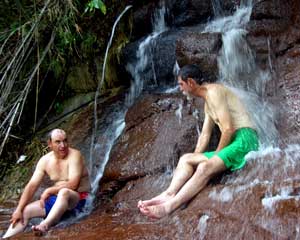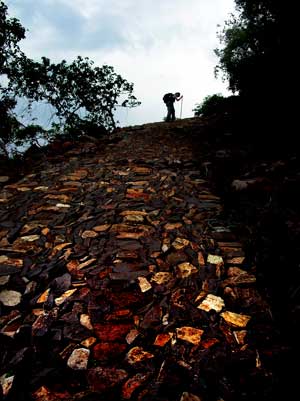Outside Guadalajara
The Long Road to La Bolsa
Nature’s spa on the Río Verde
By John Pint
Updated September, 2013
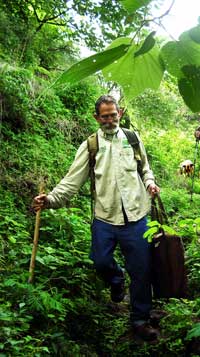 Professor Miguel Cházaro is the number one botanist of Jalisco and his
wanderings in search of plants sometimes lead him to exotic sites that few eyes
have ever seen. When he began to describe a place just beyond Acatic called La
Bolsa (The Bag) my ears began to tingle.
Professor Miguel Cházaro is the number one botanist of Jalisco and his
wanderings in search of plants sometimes lead him to exotic sites that few eyes
have ever seen. When he began to describe a place just beyond Acatic called La
Bolsa (The Bag) my ears began to tingle.
“There’s a hot waterfall at La Bolsa, with a nice pool beneath it. Well, it’s
actually not too hot: perfect bathing temperature, I’d say, and it’s right at
the edge of a huge orchard where ripe mangoes drop right into your hands, and,
by the way, just above the orchard there’s an archeological site with a big
pyramid and…”
Of course, I was hooked and so were a lot of other hiker friends when I told
them Cházaro’s story. The result was a big turnout for a hike to La Bolsa.
“How far away is this place?” people asked me.
“Miguel says it’s just half an hour from town.”
“What should we bring?”
“Lunch and a swim suit is all you need.”
|
Well, the “half-hour trip” took two hours, which did not surprise me too much,
but instead of arriving at the hot waterfall, we found ourselves on the edge of
a tremendous canyon, at the bottom of which we could barely make out a narrow
ribbon of brown: the not-exactly green Río Verde.
HMMM ... The Hams and
friends checking out the muddy road that would lead us to the edge of the
canyon. |
 |
|
“Just follow me,” said our guide, Miguel Loza of Acatic and over the edge we
went, slipping and sliding on muddy trails that zigzagged through thick maleza
which slowly turned into a full-blown jungle as we descended. All of us figured
the waterfall must be “a half hour” down the hill, but it soon became clear we
were heading for the very bottom of the canyon.
"Go for
it, it's only half an hour!" Susan Street urges us on.
|
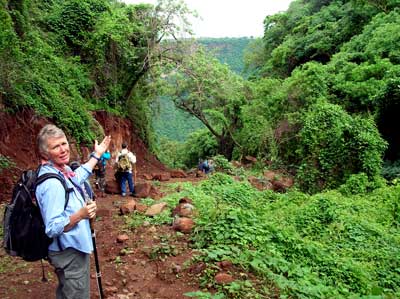 |

Down into the Jungle |
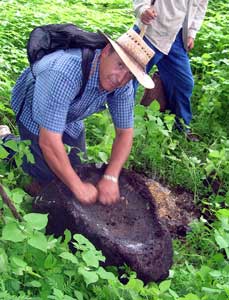 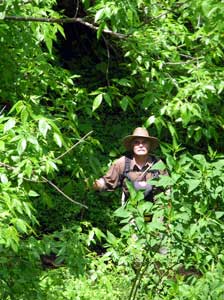
One hour later, we came to a wide, flat, open area dominated by a conspicuous,
high, lozenge-shaped mound where Miguel Loza showed us the biggest metate
I have ever seen...
Left: "There
are lots more artifacts all around here," Miguel Loza tells us.
Right: Pedro Fernandez Somellera, exploring the
deep jungle. |
|
...As he chatted, we sat down on some
convenient rocks, but were immediately warned only to sit on dry ones...
The Mound |
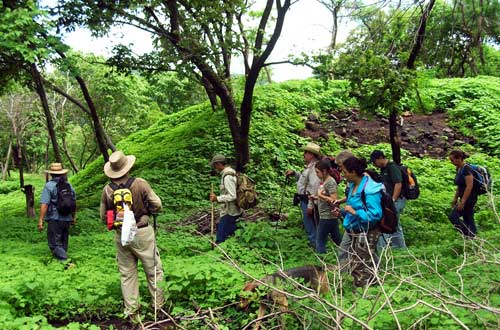 |
|
“...If you sit on a wet rock, you may end up full of aradores, which are microscopic
mites
(Sarcoptes scabiei) that bore into your skin and give you mange,” said Señor Loza, who then
launched into a talk about the history of the area...
The mighty mite; illustration courtesy of
The Free Dictionary.
|
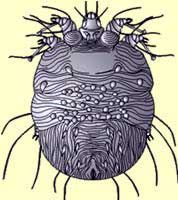 |
“The Aztecs arrived at Acatic in the year 1200 and almost decided to make it
their capital because they saw an eagle land there. However, the eagle took off
again and so did the Aztecs, wandering away to what is now Mexico City, where
they finally saw the omen they were seeking: an eagle devouring a snake while
perched on a nopal (prickly pear cactus).”
|
Miguel Cházaro, of course, was busy this whole time collecting plants. “This is
called cempasúchil or flor de muertos. It’s a kind of marigold and is used to
decorate altars on the Day of the Dead. And here is the native passion flower
from which all commercial varieties were derived.”
The wild Passion Flower
|
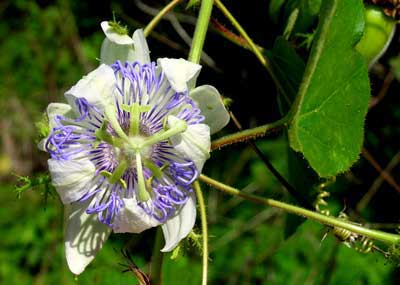 |
Señor Loza is a school teacher and said he would have enjoyed giving us a
complete tour of all the ruins he has found near the Great Mound, but we were
anxious to reach the hot spring, so we continued slip-sliding our way downhill.
|
The sun had come out at this point and we were dripping with sweat when we
suddenly plunged into a thick, dark forest of tall trees whose tops formed a
tight canopy that let very little light through, offering us much appreciated
coolness as well as all the juicy mangoes we could eat.
A fig tree among the mangoes.
|
 |
|
We trod on a thick bed of moldering leaves as we made our way to the famous hot
spring. It was a shallow pool, less than two meters in diameter and much too hot
to bathe in. However, a stream from the spring runs down through the forest to
the river bank, allowing the water to cool down a bit.
Miguel Loza at the hot spring.
|
 |
Finally, four hours after leaving Guadalajara, we reached our long-awaited hot
waterfall. Ah, but for most of the group it was quite a disappointment. “The
bathing spot looked great,” stated one exhausted hiker, “but to get to it, you
had to climb down a fallen tree trunk, hanging on for dear life above the
roaring, chocolate-colored Rio Verde. I was not quite prepared to do that.”
|
As a result, only three out of the crowd of twenty actually got a chance to
stretch out under the marvelous hot waterfall they had striven so hard to reach.
I was one of those lucky three and as I lay beneath the falls with jets of
deliciously hot water pummeling my back in a soothing massage, I asked myself,
“Was it worth it?”
John Pint in the
soothing hot stream
|
 |
For me, the reply was a resounding “Claro que sí!” but for those others, who now
faced the prospect of climbing back up the canyon’s muddy trails in the pouring
rain, the answer may have been quite the opposite, especially for the ones who
got lost along the way and particularly for one exhausted soul who felt he was
ready to lay down and die rather than start back up the long, steep trail to the
top of the barranca.
 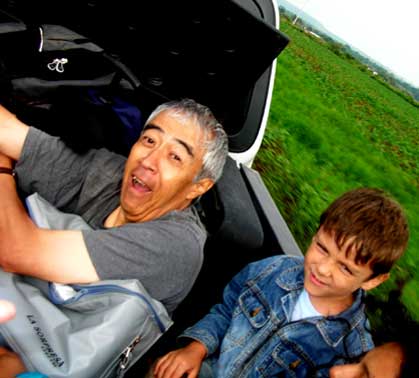 . .
Whee! The wild
and muddy ride back. |
Fortunately, he and everyone else eventually made it to the top, although a few
reached there at sunset. Then a number of us spent many days scratching the
places where the infamous aradores had managed to bore into our skin. By
the way, local people say you get rid of them by lathering each point of attack
with a thick layer of petroleum jelly and those of us who were suffering from
mange found this effective. These aradores may be the same as the guinas
we have all picked up exploring cave entrances.
If, after reading all this, you’d still like to visit this unforgettable place,
you now know that it will definitely take more than half an hour. The easiest
way to arrange a trip may be to contact Miguel Loza in Acatic (Tel:
01-378-715-1961). And don’t forget your swim suit!
|
How to Get There
(Green = See GPS coordinates below)
Near Tonalá take the Tollroad-Autopista heading for Mexico City. Fifteen minutes
later the road divides. You want the turnoff to Autopista 54D heading for
Tepatitlán. A half hour later take the Acatic exit. Drive straight to the plaza
in Acatic and turn left. Drive west for 6.3 kilometers until you come to a
rustic country church. Take the right fork at the church and continue north for
about a kilometer and a half or until the mud stops you (rainy season). The
edge
of the canyon is about 2 kilometers north of the church. Head down the trail.
Sometimes there are forks “most of which” join back up with the mail trail.
Hopefully you will pass the lozenge-shaped pyramid in an open, flat grassy area
lying just west of the trail. Continue downhill to the mango forest and head
west, just above the Rio Verde, to the hot spring. Driving time from Tonalá to
the trailhead on the canyon edge: less than one hour.
Chocolate-colored
waterfalls on the far side of the deep canyon.
|
 |
GPS info:
Country Church: 13 Q 711690 2300028
Edge of Canyon: 13 Q 711209 2302208
Pyramid: 13 Q 710666 2302565 (approximate)
Hot Spring: 13 Q 710505 2303113 (approximate)
HOME
 Professor Miguel Cházaro is the number one botanist of Jalisco and his
wanderings in search of plants sometimes lead him to exotic sites that few eyes
have ever seen. When he began to describe a place just beyond Acatic called La
Bolsa (The Bag) my ears began to tingle.
Professor Miguel Cházaro is the number one botanist of Jalisco and his
wanderings in search of plants sometimes lead him to exotic sites that few eyes
have ever seen. When he began to describe a place just beyond Acatic called La
Bolsa (The Bag) my ears began to tingle.















